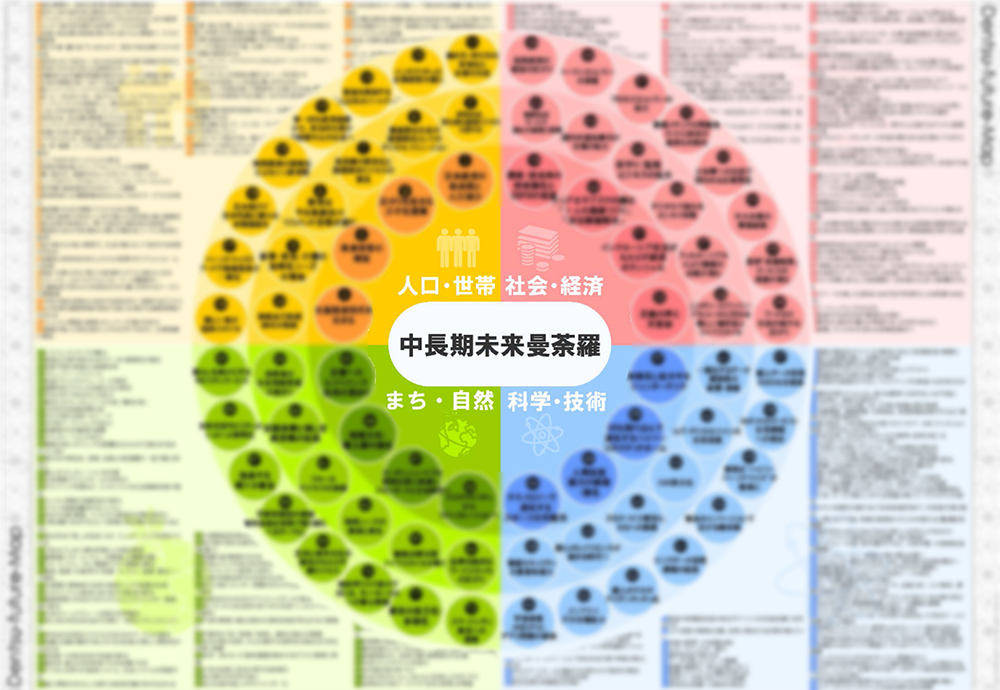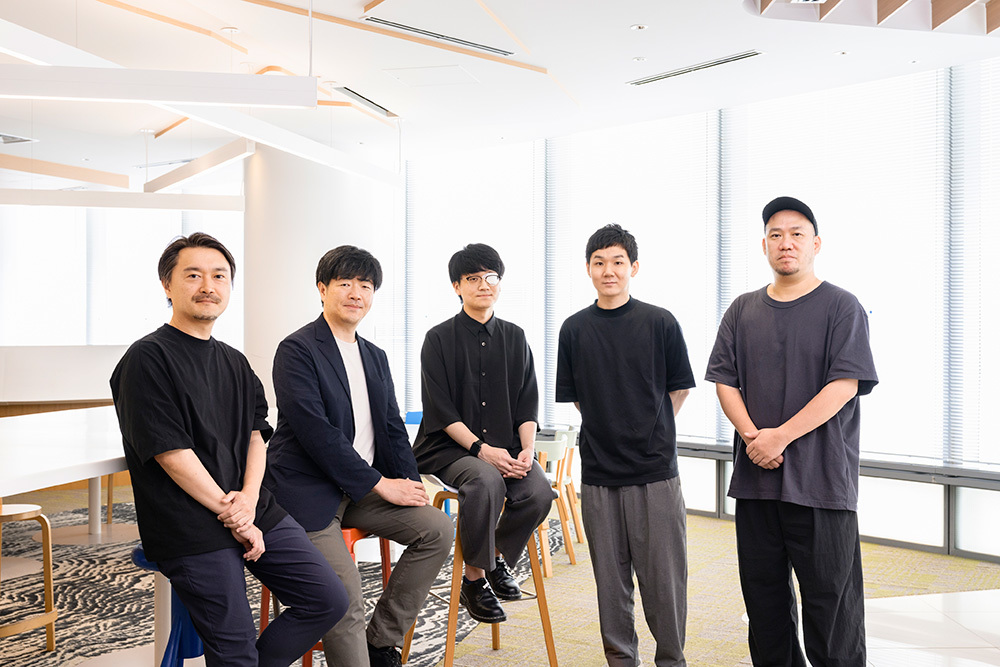
From left: Hitachi Ltd. Takuya Akashi, Hiroyuki Ochi; Dentsu Digital Inc. Yuta Takahashi; Dentsu Inc. Kazuya Kishimoto, Kazuhito Ochi
" AI for EVERY," a project by Hitachi, Ltd., Dentsu Inc., and Dentsu Digital Inc., aims to build better connections between consumers, businesses, and society using generative AI to solve various social challenges.
"Today's Whimsical Recipe," created to reduce food loss, is one such initiative. Solving the broad theme of "social challenges" with generative AI requires both forward-thinking "creative power" and "implementation power."
This time, we present a roundtable discussion featuring Mr. Hiroyuki Ochi and Mr. Takuya Akashi from Hitachi, Ltd. (hereinafter Hitachi), who lead the project; Mr. Kazuhito Ochi from Dentsu Lab Tokyo; Mr. Kazuya Kishimoto from Dentsu Inc.; and Mr. Yuta Takahashi from Dentsu Digital Inc.
Using "Today's Whimsical Recipe" as a starting point, the discussion expanded in multiple directions through the chemical reaction between Hitachi and Dentsu Inc., covering each other's creative and implementation capabilities, and ultimately reaching the true value of generative AI.
*To distinguish between the two Ochi participants, Hitachi's Ochi is referred to as "Ochi (Hitachi)" and Dentsu Inc.'s Ochi as "Ochi (Dentsu Inc.)".
Hitachi and Dentsu Inc.'s Synergy. "Today's Whimsical Recipe" Born from Technology-Driven + Challenge-Driven Approaches
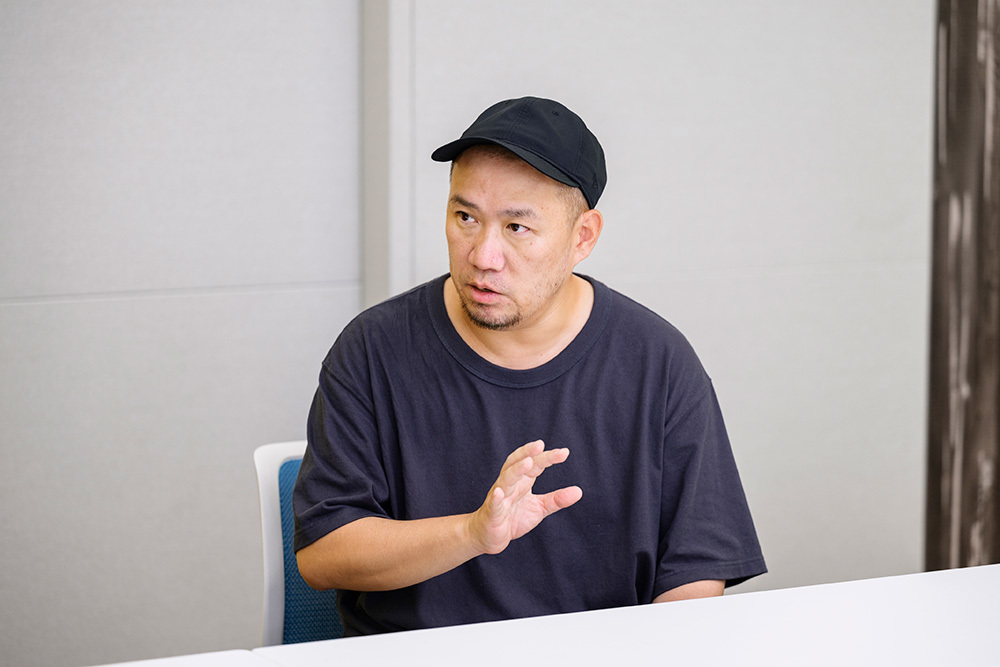
Kazuhito Ochi, Dentsu Inc.
Ochi (Dentsu): Today, we have two members from Hitachi, participating in "AI for EVERY," and three from the Dentsu Group. We'd like to have a wide-ranging discussion about "Today's Whimsical Recipe" and how each company approaches generative AI!
First, a quick introduction: I originally worked in copywriting and commercial production, but now I'm involved in digital and technology-driven creative work at Dentsu Lab Tokyo. Given our many AI-related initiatives, I joined the "AI for EVERY" project.
Kishimoto: I'm also part of Dentsu Lab Tokyo, where I've worked on communication initiatives and tool development using technology. Currently, I'm heavily involved in projects using generative AI and sound/music, handling everything from surveys and planning to prototyping, and occasionally implementation.
Takahashi: I work at Dentsu Digital Inc., where I primarily provide consulting support for corporate DX and digital marketing. For "Today's Whimsical Recipe," I collaborated with Kishimoto and others on the planning and proposal.
Ochi (Hitachi): At Hitachi, I primarily provide consulting and technical support for machine learning and data science. For "AI for EVERY," I'm responsible for coordinating the collaboration with the Dentsu Group.
Akashi: Also at Hitachi, I lead the design department within our digital business division. Originally a hardcore product designer, I worked on hardware like elevators and medical devices. As our business expanded, my design work shifted domains—from products to interactions, services, and now experiences.
Ochi (Dentsu Inc.): Thank you! Today, through this roundtable discussion, I hope we can highlight the differences and commonalities in "creative thinking" and "implementation capabilities" between Hitachi and the Dentsu Group.
First, could we hear from Mr. Takahashi of Dentsu Digital Inc., who has been involved since the project's inception, about the thinking behind the "AI for EVERY" initiative and its first solution, "Today's Whimsical Recipe"?
※Today's Whimsical Recipe =
Based on Hitachi's inventory management system and supply/demand forecasting and order processing system, it highly accurately predicts "ingredients likely to remain unsold." Generative AI, trained on insights from Dentsu Inc. creators, then generates unique recipes and coupons related to those ingredients. Leveraging the know-how of Dentsu Digital Inc.'s " ∞AI Ads," these recipes and coupons are automatically generated as promotional materials and distributed via store apps and in-store digital signage.
Takahashi: Originally, Dentsu Digital Inc. participated in Hitachi's " Lumada Alliance Program," collaborating in the DX domain. Through this, we deepened our understanding of each other's strengths: Hitachi excels in supporting frontline workers in the field, while Dentsu Digital Inc. possesses technology and marketing expertise in the toC domain.
The idea that combining these strengths could enable us to broadly cover both B2B and B2C domains while tackling various social challenges led to the creation of the generative AI service project, "AI for EVERY."
Regarding "Today's Whimsical Recipe," we started from the fundamental premise of combining Hitachi and Dentsu Group's strengths. We then explored potential points of convergence from both technological and social challenge perspectives. This led us to the realization that combining Hitachi's proven "demand forecasting" with Dentsu Group's expertise in "advertising delivery," creative solutions using generative AI, and their associated technologies and insights could potentially address the social challenge of "food loss."
When we presented Hitachi with ideas for solving food loss, they commented, "Recipe generation sounds good too." Similarly, when we sought input from Dentsu Inc.'s Kishimoto and others, they also suggested recipe generation. Integrating these ideas comprehensively led to the evolution of "Today's Whimsical Recipe," a system that generates recipes.
Ochi (Hitachi): By the way, Hitachi's demand forecasting system predicts which products or ingredients will sell that day and the level of demand based on historical sales data and various parameters.
Ochi (Dentsu): So, the technical idea of "using Hitachi's demand forecasting technology to reduce food loss" was one starting point. On the other hand, you mentioned choosing food loss as the subject from a social issue perspective. What led you to consider this topic?
Takahashi: There were two main reasons. First, myself and other members had relatively extensive exposure to social issues. Dentsu Digital Inc. had previously undertaken initiatives like analyzing social issues using social data, accumulating broad insights into societal challenges. This gave us a general sense of "this technology could potentially address that issue."
The other factor was the unique "consumer perspective" inherent to the Dentsu Group. For example, when "supermarkets" emerged as a keyword during the aforementioned social issue analysis, I visited supermarkets—without interfering with sales—to observe how products were being purchased. There, I noticed that purchase decisions were heavily influenced by discounted items. I also witnessed interactions like store staff saying, "We don't discount items once they're in the cart." These observations led me to believe this could be a consumer issue worth exploring further.
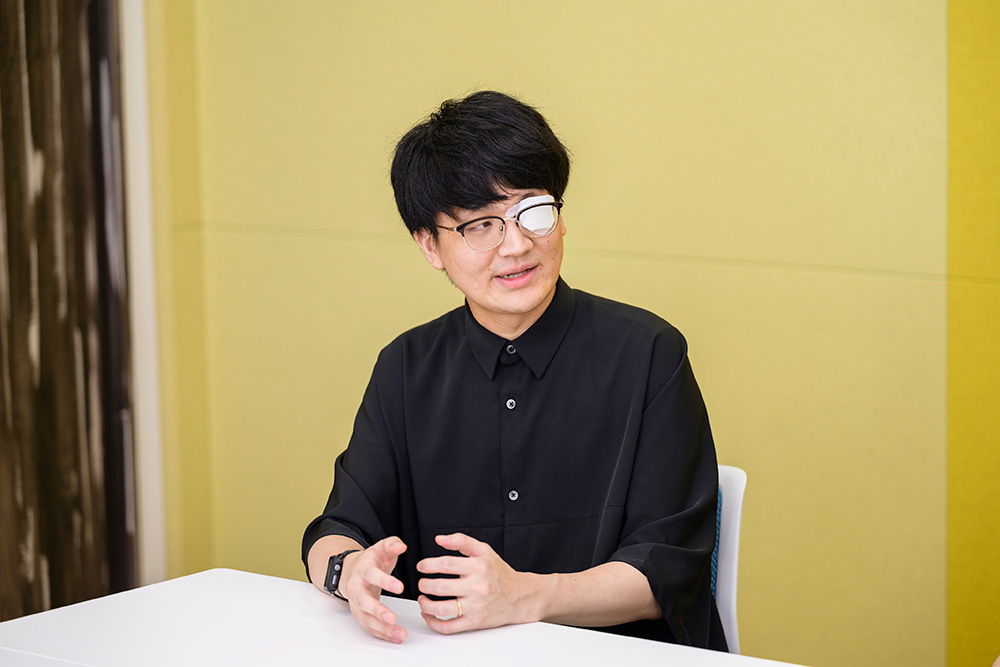
Dentsu Digital Inc., Yuta Takahashi
Kishimoto: We then refined the plan by incorporating insights from examples in the global advertising industry and service design. Having previously worked on projects addressing food loss through non-standard vegetables, I proposed this technology thinking, "This might just be the right fit," as a natural extension of that work.
At Dentsu Lab Tokyo, we often tackle challenges alongside clients' R&D departments. In those cases, we typically start by researching the client's technology seeds and investigating how adjacent technologies are used and perceived in the world. Then, we often approach ideas from a "technology-first" perspective.
On the other hand, as Mr. Takahashi also does, we frequently think from a "problem-based" perspective. To solve societal issues, we consider whether approaches exist that don't rely on technology in the first place, or what combination of technologies—like research papers and open-source code—can solve problems more effectively. We move back and forth between technology-based and problem-based thinking.
What happens when the creative power and implementation strength of 'society-driven Hitachi' and 'people-driven Dentsu Inc.' fuse?
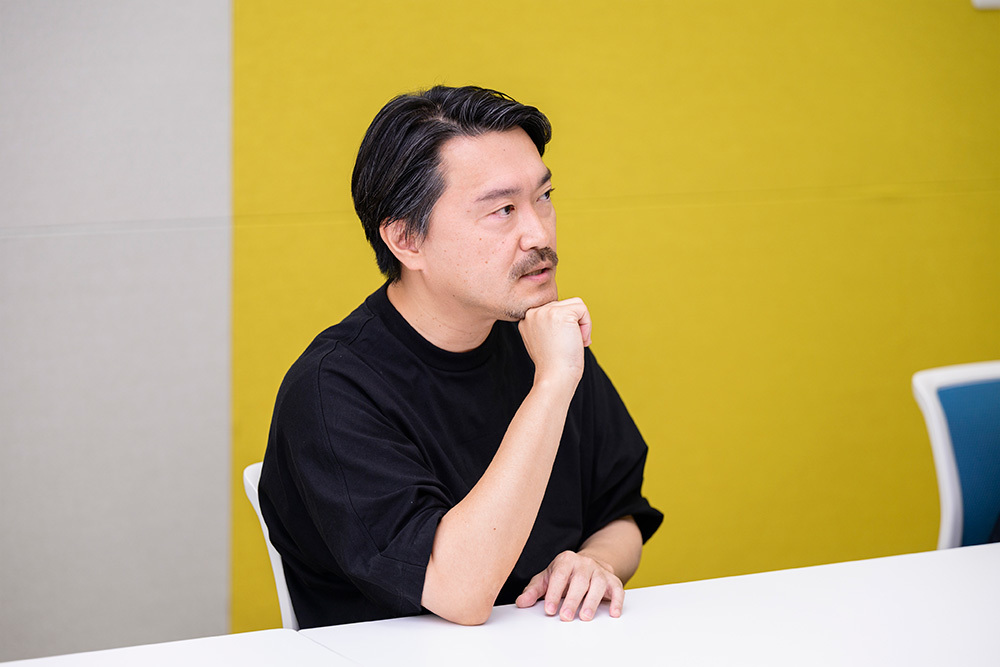
Hitachi, Ltd. Takuya Akashi
Ochi (Dentsu): What did you think of the idea for "Today's Whimsical Recipe"?
Akashi: Consumer psychology actually manifests in incredibly fleeting moments, right? For instance, when a user hesitates for a split second, thinking, "Buying ingredients that might go to waste is socially good, but what should I make with them?" we can nudge them forward with "recipe generation." In other words, I thought it was an excellent concept as that final push to change people's behavior.
Incidentally, we also conduct extensive field observations to study consumer behavior. While "regions" are the most straightforward and manageable units for examining social issues, I believe it's crucial to investigate "why a particular social issue exists within that specific region."
Let me share one case from Hitachi where we tackled local production for local consumption at the community level. In Kokubunji City, Tokyo, there's a project called "Kokubegi" that promotes vegetables produced by local farmers. "Kokubegi" involves producers, and there are also restaurants that serve dishes using "Kokubegi" vegetables. Freshly harvested vegetables are collected from farms, delivered to restaurants, and then consumed by citizens at each establishment. While local production for local consumption seems to be functioning well at first glance, through repeated discussions with project members and farmers, we discovered that the "means of transportation" to get produce from producers to the point of consumption was a key challenge.
Of course, everyone involved with "Kokubegi" is working hard to transport the vegetables. However, to truly achieve local production for local consumption, we needed to combine distribution with citizen participation. In other words, we wanted citizens to participate in the process of "delivering vegetables to restaurants," fostering local culture and activities while solving the transportation challenge. We launched an initiative where citizens also participate in moving the produce. This became a case where we first identified the specific challenges before considering solutions.
Ochi (Dentsu Inc.): I thought, "Ah, I see!" about Hitachi's approach—their field-oriented mindset, valuing reality, and researching real challenges. Dentsu Inc. also values seeing the field and does a lot of ideation. But because Hitachi and the Dentsu Group have different cultures and engage with different challenges, their approaches to ideation and implementation seem different. For example, Hitachi has a unique initiative called "Vision Design." Could you tell us more about that?
Akashi: Hitachi champions the purpose of "Social Innovation," so I get the impression many of our designers and engineers genuinely take social challenges personally and deeply consider how people and society can achieve happiness. Within this context, I lead an initiative called the "Vision Design Project." Simply put, it's "Hitachi's design activity for envisioning the future."
When we launched Vision Design 15 years ago, terms like "smart city" and "smart factory" were trending in society. In 2016, the Japanese government announced the "Society 5.0" initiative, which was later referenced by Hiroaki Nakanishi, then Chairman of our company, in his speech at the Asahi Global Forum 2018. Within this framework, the concept presented as a goal to achieve was the Super-smart society.
But then I thought: in business contexts, the word "smart" is often used in the context of Optimization, Automation, or Efficiency. Yet it also carries meanings like Thoughtful or Clever.
In other words, is the path of optimization, automation, and efficiency truly the path to human happiness? As designers tackling "social innovation," we needed to pause and ask that question. That's how our "Vision Design" initiative began.
Ochi (Den): So there was a hypothesis that the "smart" Society 5.0 refers to doesn't necessarily mean superficial "smart"? You started from the question: "Are new technologies fundamentally beneficial to humans in the first place?"
Akashi: Yes. Of course, optimization, automation, and efficiency should make things more convenient. Automating a task might free up time previously spent on it, allowing us to use that time for something else. But we realized we couldn't truly answer "Does that really make us happy?" without also exploring different forms of happiness.
That's why we started the "Vision Design" initiative. We named it "Beyond Smart" – not just making things "smart," but seeking what lies beyond smart. As the design team, we felt a burning sense of mission (laughs), believing we had to identify potential challenges technology might pose to people, even if they originated within Hitachi itself.
Ochi (Electrical): In "Vision Design," you're also focusing on "problems that new technology might unintentionally bring about," aren't you?
Akashi: I believe people might feel uneasy when data analysis and the accompanying transparency of information become deeply embedded in society. For example, if the probability of getting sick becomes quantifiable. Hearing "You have a 30% chance of getting sick" drastically changes your perception of illness compared to before. At that point, will you choose to live without worrying about the number? Or will you confront that 30% head-on and try to change your lifestyle to reduce it to 10%? Ultimately, it becomes a question of your "attitude," but I still think life would become harder if you didn't change.
This future insight is just one example, but we created many others like it. Hitachi believes it's essential to maintain a perspective on how consumers' values, and ultimately human values, will evolve in the future. We've compiled these perspectives into a collection we call "Signs." The research compiled in 2010 was named "25 Signs." Since it was created with 2025 in mind, this year we want to check back and see "This really happened" or "Progress exceeded expectations." The impact of the novel coronavirus has been significant. Some things we predicted would be "commonplace in 15 years" rapidly became "commonplace" during the pandemic, which is fascinating.

※From Vision Design
Ochi (Dentsu Inc.): I see! I thought Hitachi and the Dentsu Group had different approaches to ideation and implementation, but hearing you speak, I sense a common ground in your ultimate goals. From the perspective of function and emotion, there's a drive to pursue the cutting edge of society in terms of functionality, while simultaneously focusing on human emotion to consider the value that functionality provides. That similarity is striking.
Takahashi: My impression of Hitachi was that it's a company deeply involved in social systems and infrastructure. But it's not just that. I think you have a structure that can see both the big picture of "society" and the micro level of "each individual person," moving back and forth between them to ultimately take an approach that changes the world. That's something the Dentsu Group shares too.
While we share the common ground of "discovering and solving problems by moving back and forth between people and society," Hitachi leverages its implementation capabilities to approach things from the "society" side. In contrast, the Dentsu Group focuses on the "people" side, consciously changing individual mindsets and behaviors one by one to drive societal change. I feel the difference between us lies in which side we ultimately choose to approach from.
Incidentally, you mentioned "signs" earlier. The Dentsu Group similarly has a mid-term future forecasting tool called the "Dentsu Future Mandala." It imagines how society will change over the medium to long term, starting from facts, and compiles how consumers' lives will transform. That's another commonality with Hitachi.
Ochi (Hitachi): I also think our aspirations, or rather our shared vision of "how things should be," are quite similar. Earlier, you mentioned wanting to broadly cover both B2B and B2C domains while addressing various social challenges. But from the recipient's perspective, there's no real distinction between B2B and B2C, right?
When considering UX (user experience), I believe players providing value as B2B and players providing value as B2C come together to realize a single experiential value. In that sense, I think Hitachi and the Dentsu Group are a good combination.
When consumers are hesitating at that final push point, Dentsu Inc.'s communication power moves their feelings. Behind the scenes, Hitachi provides the " " – the mechanisms and systems that must be in place.
Partnering creates new perspectives and sparks ideas that go "one step further."
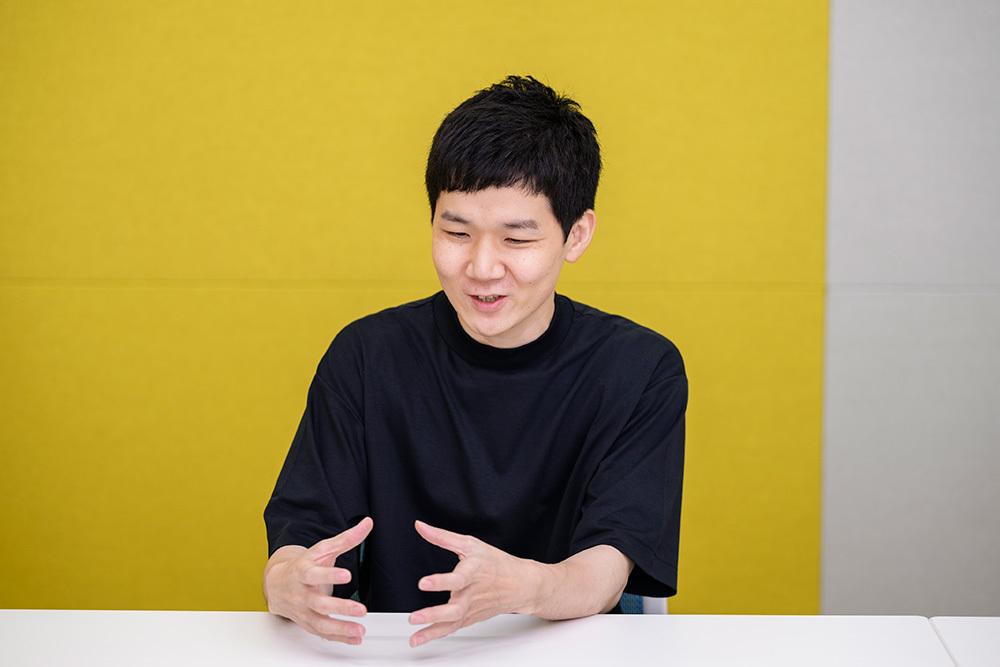
Dentsu Inc., Kazuya Kishimoto
Ochi (Dentsu Inc.): Precisely as you both mentioned, Dentsu Inc. focuses on creating more consumer-centric touchpoints and solving their problems, while Hitachi holds significant connections to the broader society underlying those consumers. What are your thoughts, Mr. Kishimoto?
Kishimoto: At Dentsu Inc., we refer to the various touchpoints with consumers, including media, as "contact points." Our core work lies in meticulously considering how to communicate with consumers at these contact points and effectively expressing that communication.
For example, earlier Mr. Akashi mentioned "when there's a 30% chance of getting sick." If we were to directly state "You have a 30% chance of getting sick" in communication strategies or on products/services, I feel consumers would likely react with a slight "Ugh."
So, we might consider having a character say something like "You're getting into dangerous territory," or designing a product that vibrates to alert users. We often talk about "charming ways of conveying messages" or "communication design," but the question of "how can we communicate this better?" is something we constantly ponder when engaging with consumers.
Takahashi: The strength of the Dentsu Group lies in its ability to refine everything from strategy to the minutest details of deliverables in corporate communications. Take "Today's Whimsical Recipe"—if the sole goal were to reduce food waste, we could simply discount ingredients likely to go unsold instead of creating recipes. But doing only that might lead to excessive discounts, potentially undermining the company's business viability.
In that sense, 'recipe generation' is a quintessentially Dentsu Inc. approach: providing consumers with the 'value' of ingredients and products beyond just price—essentially changing how they're presented. It's about how to get people to buy without diminishing the product's value.
Ochi (Dentsu Inc.): It's a subtle tweak, right? Telling people "It's cheap because it's leftover" doesn't really move them. Instead, presenting it positively—like "Combine this with that, and you can make something this delicious"—is the kind of approach and design Dentsu Inc. envisions.

Hitachi Ltd. Mr. Hiroyuki Ochi
Ochi (Hitachi): Hearing that makes me think. When Hitachi discusses challenges with B2B clients, the perspective often gets confined to "how that client perceives their challenge." We tend to stop at realizing the society or future imaginable from that viewpoint. To take it one step further—to make it smarter, more innovative, and better—we need to broaden that perspective even more.
Take the ride-hailing service "Uber" as an example. The very concept of utilizing resources (cars) from ordinary people, not taxi operators, was incredibly novel. It's realized through an application that effectively matches users and providers, combined with various technologies like route search.
While Hitachi wasn't involved in this service, I think such an idea would have been hard to conceive if discussions had only been between taxi companies and Hitachi. It emerged by combining the user's challenge—"I want a ride immediately and to reach my destination cheaply"—with the provider's idea—"I have both a car and free time, so I can help."
In other words, by partnering with Dentsu Inc. and broadening the scope of challenges beyond just clients to encompass society and consumers, I believe we can achieve "greater smartness." While "AI for EVERY" primarily targets BtoBtoC, we also expect it to help discover end-user challenges, the toC aspect.
Ochi (Dentsu Inc.): I totally get the Uber example! We at Dentsu Inc. also want to solve more consumer challenges, but since we're ad-based, our scope is quite limited. Sometimes we can't reach full implementation or real problem-solving. To put it plainly, we often end up just at the "expression" stage. We can't build infrastructure, not by a long shot. But partnering with Hitachi might let us achieve that next step of implementation.
I thought that by leveraging Dentsu Inc.'s strength in scaling and Hitachi's implementation capabilities, we could achieve a good balance and solve BtoBtoC challenges effectively.
Continued in Part 2.
















